| 登録情報 | データベース: PDB / ID: 4xi3
|
|---|
| タイトル | Estrogen Receptor Alpha Ligand Binding Domain in Complex with Bazedoxifene |
|---|
 要素 要素 | Estrogen receptor |
|---|
 キーワード キーワード | SIGNALING PROTEIN / Estrogen Receptor / SERM / Bazedoxifene / Breast Cancer / Nuclear Hormone Receptor |
|---|
| 機能・相同性 |  機能・相同性情報 機能・相同性情報
regulation of epithelial cell apoptotic process / antral ovarian follicle growth / regulation of branching involved in prostate gland morphogenesis / RUNX1 regulates transcription of genes involved in WNT signaling / RUNX1 regulates estrogen receptor mediated transcription / regulation of toll-like receptor signaling pathway / nuclear estrogen receptor activity / epithelial cell development / steroid hormone receptor signaling pathway / epithelial cell proliferation involved in mammary gland duct elongation ...regulation of epithelial cell apoptotic process / antral ovarian follicle growth / regulation of branching involved in prostate gland morphogenesis / RUNX1 regulates transcription of genes involved in WNT signaling / RUNX1 regulates estrogen receptor mediated transcription / regulation of toll-like receptor signaling pathway / nuclear estrogen receptor activity / epithelial cell development / steroid hormone receptor signaling pathway / epithelial cell proliferation involved in mammary gland duct elongation / prostate epithelial cord elongation / prostate epithelial cord arborization involved in prostate glandular acinus morphogenesis / mammary gland branching involved in pregnancy / uterus development / negative regulation of smooth muscle cell apoptotic process / vagina development / TFIIB-class transcription factor binding / androgen metabolic process / mammary gland alveolus development / cellular response to estrogen stimulus / estrogen response element binding / Mitochondrial unfolded protein response (UPRmt) / nuclear receptor-mediated steroid hormone signaling pathway / positive regulation of DNA-binding transcription factor activity / negative regulation of DNA-binding transcription factor activity / Nuclear signaling by ERBB4 / RNA polymerase II preinitiation complex assembly / positive regulation of nitric-oxide synthase activity / estrogen receptor signaling pathway / protein localization to chromatin / steroid binding / 14-3-3 protein binding / TFAP2 (AP-2) family regulates transcription of growth factors and their receptors / negative regulation of canonical NF-kappaB signal transduction / ESR-mediated signaling / TBP-class protein binding / negative regulation of miRNA transcription / nitric-oxide synthase regulator activity / nuclear estrogen receptor binding / transcription corepressor binding / transcription coregulator binding / stem cell differentiation / SUMOylation of intracellular receptors / cellular response to estradiol stimulus / euchromatin / beta-catenin binding / Nuclear Receptor transcription pathway / response to estrogen / transcription coactivator binding / male gonad development / nuclear receptor activity / positive regulation of fibroblast proliferation / Constitutive Signaling by Aberrant PI3K in Cancer / Regulation of RUNX2 expression and activity / positive regulation of nitric oxide biosynthetic process / sequence-specific double-stranded DNA binding / Ovarian tumor domain proteases / response to estradiol / PIP3 activates AKT signaling / positive regulation of cytosolic calcium ion concentration / ATPase binding / PI5P, PP2A and IER3 Regulate PI3K/AKT Signaling / regulation of inflammatory response / fibroblast proliferation / DNA-binding transcription activator activity, RNA polymerase II-specific / phospholipase C-activating G protein-coupled receptor signaling pathway / transcription regulator complex / Estrogen-dependent gene expression / DNA-binding transcription factor activity, RNA polymerase II-specific / calmodulin binding / Extra-nuclear estrogen signaling / RNA polymerase II cis-regulatory region sequence-specific DNA binding / chromatin remodeling / DNA-binding transcription factor activity / negative regulation of gene expression / chromatin binding / regulation of DNA-templated transcription / regulation of transcription by RNA polymerase II / protein kinase binding / chromatin / positive regulation of DNA-templated transcription / enzyme binding / negative regulation of transcription by RNA polymerase II / Golgi apparatus / signal transduction / positive regulation of transcription by RNA polymerase II / protein-containing complex / zinc ion binding / nucleoplasm / identical protein binding / nucleus / membrane / plasma membrane / cytoplasm / cytosol類似検索 - 分子機能 Oestrogen-type nuclear receptor final C-terminal domain / Oestrogen-type nuclear receptor final C-terminal / Estrogen receptor / : / Oestrogen receptor / Estrogen receptor/oestrogen-related receptor / : / Retinoid X Receptor / Retinoid X Receptor / Nuclear hormone receptor ...Oestrogen-type nuclear receptor final C-terminal domain / Oestrogen-type nuclear receptor final C-terminal / Estrogen receptor / : / Oestrogen receptor / Estrogen receptor/oestrogen-related receptor / : / Retinoid X Receptor / Retinoid X Receptor / Nuclear hormone receptor / Nuclear hormones receptors DNA-binding region signature. / Zinc finger, nuclear hormone receptor-type / Double treble clef zinc finger, C4 type / Nuclear hormone receptors DNA-binding domain profile. / c4 zinc finger in nuclear hormone receptors / Nuclear hormone receptor, ligand-binding domain / Nuclear hormone receptor-like domain superfamily / Ligand-binding domain of nuclear hormone receptor / Nuclear receptor (NR) ligand-binding (LBD) domain profile. / Ligand binding domain of hormone receptors / Zinc finger, NHR/GATA-type / Orthogonal Bundle / Mainly Alpha類似検索 - ドメイン・相同性 |
|---|
| 生物種 |  Homo sapiens (ヒト) Homo sapiens (ヒト) |
|---|
| 手法 |  X線回折 / X線回折 /  シンクロトロン / シンクロトロン /  分子置換 / 解像度: 2.491 Å 分子置換 / 解像度: 2.491 Å |
|---|
 データ登録者 データ登録者 | Fanning, S.W. / Mayne, C.G. / Toy, W. / Carlson, K. / Greene, B. / Nowak, J. / Walter, R. / Panchamukhi, S. / Tajhorshid, E. / Nettles, K.W. ...Fanning, S.W. / Mayne, C.G. / Toy, W. / Carlson, K. / Greene, B. / Nowak, J. / Walter, R. / Panchamukhi, S. / Tajhorshid, E. / Nettles, K.W. / Chandarlapaty, S. / Katzenellenbogen, J. / Greene, G.L. |
|---|
| 資金援助 |  米国, 1件 米国, 1件 | 組織 | 認可番号 | 国 |
|---|
| Department of Defense (DOD, United States) | BC131458P1 |  米国 米国 |
|
|---|
 引用 引用 |  ジャーナル: Elife / 年: 2018 ジャーナル: Elife / 年: 2018
タイトル: The SERM/SERD bazedoxifene disrupts ESR1 helix 12 to overcome acquired hormone resistance in breast cancer cells.
著者: Fanning, S.W. / Jeselsohn, R. / Dharmarajan, V. / Mayne, C.G. / Karimi, M. / Buchwalter, G. / Houtman, R. / Toy, W. / Fowler, C.E. / Han, R. / Laine, M. / Carlson, K.E. / Martin, T.A. / ...著者: Fanning, S.W. / Jeselsohn, R. / Dharmarajan, V. / Mayne, C.G. / Karimi, M. / Buchwalter, G. / Houtman, R. / Toy, W. / Fowler, C.E. / Han, R. / Laine, M. / Carlson, K.E. / Martin, T.A. / Nowak, J. / Nwachukwu, J.C. / Hosfield, D.J. / Chandarlapaty, S. / Tajkhorshid, E. / Nettles, K.W. / Griffin, P.R. / Shen, Y. / Katzenellenbogen, J.A. / Brown, M. / Greene, G.L. |
|---|
| 履歴 | | 登録 | 2015年1月6日 | 登録サイト: RCSB / 処理サイト: RCSB |
|---|
| 改定 1.0 | 2016年1月13日 | Provider: repository / タイプ: Initial release |
|---|
| 改定 1.1 | 2019年4月10日 | Group: Author supporting evidence / Data collection ...Author supporting evidence / Data collection / Derived calculations / Structure summary
カテゴリ: pdbx_audit_support / pdbx_struct_oper_list / struct_keywords
Item: _pdbx_audit_support.funding_organization / _pdbx_struct_oper_list.symmetry_operation / _struct_keywords.pdbx_keywords |
|---|
| 改定 1.2 | 2019年11月27日 | Group: Author supporting evidence / カテゴリ: pdbx_audit_support / Item: _pdbx_audit_support.funding_organization |
|---|
| 改定 1.3 | 2023年9月27日 | Group: Data collection / Database references / Refinement description
カテゴリ: chem_comp_atom / chem_comp_bond ...chem_comp_atom / chem_comp_bond / database_2 / pdbx_initial_refinement_model
Item: _database_2.pdbx_DOI / _database_2.pdbx_database_accession |
|---|
| 改定 1.4 | 2024年3月6日 | Group: Advisory / Database references / Derived calculations
カテゴリ: citation / citation_author ...citation / citation_author / pdbx_validate_close_contact / struct_conn
Item: _citation.country / _citation.journal_abbrev ..._citation.country / _citation.journal_abbrev / _citation.journal_id_CSD / _citation.journal_id_ISSN / _citation.journal_volume / _citation.pdbx_database_id_DOI / _citation.pdbx_database_id_PubMed / _citation.title / _citation.year |
|---|
|
|---|
 データを開く
データを開く 基本情報
基本情報 要素
要素 キーワード
キーワード 機能・相同性情報
機能・相同性情報 Homo sapiens (ヒト)
Homo sapiens (ヒト) X線回折 /
X線回折 /  シンクロトロン /
シンクロトロン /  分子置換 / 解像度: 2.491 Å
分子置換 / 解像度: 2.491 Å  データ登録者
データ登録者 米国, 1件
米国, 1件  引用
引用 ジャーナル: Elife / 年: 2018
ジャーナル: Elife / 年: 2018 構造の表示
構造の表示 Molmil
Molmil Jmol/JSmol
Jmol/JSmol ダウンロードとリンク
ダウンロードとリンク ダウンロード
ダウンロード 4xi3.cif.gz
4xi3.cif.gz PDBx/mmCIF形式
PDBx/mmCIF形式 pdb4xi3.ent.gz
pdb4xi3.ent.gz PDB形式
PDB形式 4xi3.json.gz
4xi3.json.gz PDBx/mmJSON形式
PDBx/mmJSON形式 その他のダウンロード
その他のダウンロード 4xi3_validation.pdf.gz
4xi3_validation.pdf.gz wwPDB検証レポート
wwPDB検証レポート 4xi3_full_validation.pdf.gz
4xi3_full_validation.pdf.gz 4xi3_validation.xml.gz
4xi3_validation.xml.gz 4xi3_validation.cif.gz
4xi3_validation.cif.gz https://data.pdbj.org/pub/pdb/validation_reports/xi/4xi3
https://data.pdbj.org/pub/pdb/validation_reports/xi/4xi3 ftp://data.pdbj.org/pub/pdb/validation_reports/xi/4xi3
ftp://data.pdbj.org/pub/pdb/validation_reports/xi/4xi3
 リンク
リンク 集合体
集合体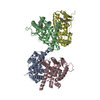
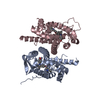

 要素
要素 Homo sapiens (ヒト) / 遺伝子: ESR1, ESR, NR3A1 / 発現宿主:
Homo sapiens (ヒト) / 遺伝子: ESR1, ESR, NR3A1 / 発現宿主: 
 X線回折
X線回折 試料調製
試料調製 シンクロトロン / サイト:
シンクロトロン / サイト:  CLSI
CLSI  / ビームライン: 08ID-1 / 波長: 0.987 Å
/ ビームライン: 08ID-1 / 波長: 0.987 Å 解析
解析 分子置換
分子置換 ムービー
ムービー コントローラー
コントローラー



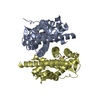
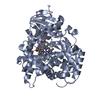

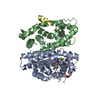


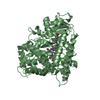

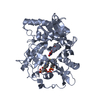
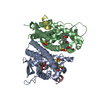
 PDBj
PDBj







